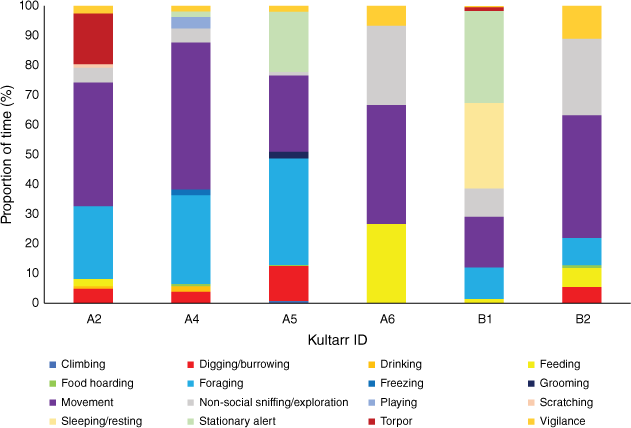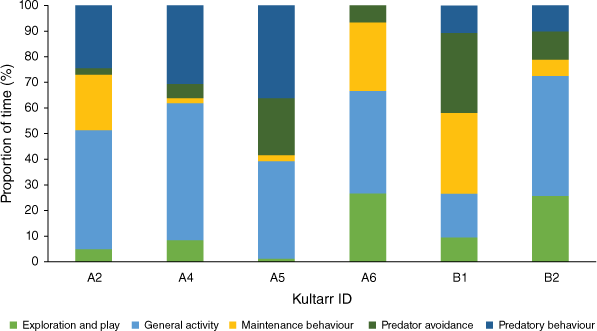Diurnal activity budget of the kultarr (Antechinomys laniger) in captivity
Hayley J. Stannard A * , Lisa M. Goodchild A and Julie M. Old
A * , Lisa M. Goodchild A and Julie M. Old  B
B
A
B
Abstract
The kultarr (Antechinomys laniger) is a small carnivorous marsupial native to arid and semiarid regions of mainland Australia. This study assessed historical video data to develop an activity budget for a captive kultarr population. The study had very limited diurnal footage and found that kultarrs spent the most time displaying movement, foraging and stationary alert behaviours. The study has contributed to our understanding of kultarr behaviour in captivity; however, more research is needed that encompasses a larger data set to fully understand kultarr activity.
Keywords: activity rhythms, behaviour, dasyurid, ethogram, ethology, marsupial, Marsupialia, welfare.
Introduction
Animals in captivity are occupying environments that differ greatly and are often substantially smaller that their natural habitats. These captive conditions often limit the behaviours and time spent performing different behaviours that can have negative welfare implications (Veasey et al. 1996; Swaisgood et al. 2001). Studying activity budgets in captive animals can be useful for understanding which behaviours are displayed and spatial use of enclosures. Determining ‘normal’ from ‘abnormal’ behaviours can be used to improve animal welfare; for example, designing behavioural enrichment, or enclosure layouts that increase desired ‘normal’ behaviours can improve mental stimulation for animals (Ross et al. 2009; de Azevedo et al. 2023). It is important to understand both diurnal and nocturnal behaviours as captivity can change when animals are active; for example, golden hamsters (Mesocricetus auratus) in captivity become strictly nocturnal, although they are diurnal in the wild (Gattermann et al. 2008). Furthermore, knowledge of behaviour of most dasyurid species, either in the wild or in captivity, is sparse or absent in the literature.
The kultarr (Antechinomys laniger) is a small marsupial that inhabits arid and semiarid regions of central Australia (Stannard and Pavey 2023). Previous research on kultarr behaviour has described the maternal and juvenile behaviours displayed by a wild-caught female with pouch young (Happold 1972), and another described behaviours in captive animals (Stannard et al. 2025). Other studies on kultarr biology include studies on thermoregulation, torpor, and basking (Geiser 1986; Stannard et al. 2015); reproduction (Valente 1984; Woolley 1984; Stannard and Old 2010); and nutrition and digestion (Stannard and Old 2011a, 2011b, 2013). To further contribute to our understanding of this species’ behaviour, this study aimed to detail the activity budgets of kultarrs in captivity. It is a retrospective study on some limited video footage.
Methods
Seven (two males and five females; Table 1) kultarrs housed at the University of Western Sydney (Richmond, New South Wales, Australia) were used for this study. Although seven animals were available for analysis, one animal did not show any diurnal behaviour and was out of sight the entire time. The kultarrs were housed in enclosures (60 cm × 60 cm × 60 cm) with glass sliding doors at the front. The floor substrate consisted of a commercial kitty litter (Breeders Choice®, Fibre Cycle, Australia). A wooden nest box (24 cm2) lined with straw was supplied in each enclosure. The room temperature was maintained at 22°C (±3°C) with natural light to provide a natural photoperiod. Animals were fed once daily on a mixed diet of insects and raw rat or mouse meat. Fresh water was supplied in a shallow dish ad libitum.
Cameras (CCTV; AVTECH, Taiwan) were positioned in the top left or right-hand corners of the enclosures facing the nest box entrance, food, and water bowls. The footage was recorded onto a digital video recorder (Panasonic, Osaka, Japan) and downloaded onto a digital video disk (DVD) for viewing. Recordings were taken from the 10–11 and 13 September 2008. Owing to technical issues with infra-red lights and the video recorder, only 10-h periods from 6 am to 4 pm were recorded, a total of 210 h. Focal sampling was used to observe and categorise behaviours for each kultarr by using an ethogram adapted from National Centre for the Replacement, Refinement & Reducation of Animals in Research (2023). No statistical analysis was applied because the data collected were mainly qualitative, with minimal quantitative measures recorded.
Results and discussion
Ethogram
Behaviours were categorised into seven general classifications, which were then further divided into 27 specific behaviours (see ethogram in Stannard et al. (2025)). No ethogram has previously been developed for kultarrs, but ethograms have been developed for studies in Tasmanian devils (Sarcophilus harrisii) and Antechnius spp. (Pemberton and Renouf 1993; Righetti et al. 2000).
Activity budget
The total time that the kultarrs were visible and active ranged from zero (for A1) to 631 min (for B1). This time equated to a very small percentage of the total time available that animals could be observed (Table 1). The six kultarrs that showed diurnal activity displayed a combined total of 16 different behaviours within five broad categories (Figs 1, 2). Common behaviours recorded for all animals were movement, non-social sniffing/exploration, and vigilance. Apart from A6, all kultarrs displayed foraging behaviour, and other behaviours recorded were exhibited only by one or only a few animals. The common behaviours observed, obtaining food and avoiding predation, are basic and necessary activities essential for survival; thus, it is not unexpected that these would be executed the most frequently.
Proportion of time spent (%) by kultarrs displaying each behaviour excluding out of sight. Note: A1 was out of sight on all days.

Proportion of time spent (%) by kultarrs displaying behaviours within each broad category. Note: A1 was out of sight on all days.

The juvenile female (A6) was the least active of the six animals that could be analysed. The young age of kultarr A1 and A6 could be a reason for the lower activity levels. Although the study occurred during the breeding season (June–February) when animals may be more active, both females were only 9 months of age and not sexually mature (Stannard and Pavey 2023). Of the other five kultarrs, four were active for less than 10% of the total time recorded. This low activity level exhibited is likely to be a reflection of only diurnal surveillance, because kultarrs are nocturnal and more likely to be sleeping and resting during these times (Stannard and Pavey 2023).
The most active kultarr (B1) was a male and behavioural observations could be made for 35% of the total available video footage, which was a markedly larger period of time than for the other kultarrs. The second-most active kultarr (A5) was also male, and it is possible that the time of year (during the breeding season) may have influenced the level of male activity.
Kultarr B2 spent most time engaging in predator avoidance, specifically being stationarily alert (195 min). Three kultarrs were observed adopting the stationary alert pose. One of the females exhibited the behaviour only for a short time; however, the two males (A5 and B1) in the study spent a much larger proportion of time, 20.3% and 30.9% respectively (Fig. 1), displaying this behaviour. Males may need to be more alert during the breeding season to find potentially receptive females, and for territorial awareness and protection especially against prospective male challengers. Related to this behaviour was the use of the ‘indecision alert’ pose, where the animal would stand still, with one front paw raised up and held off the ground, and has been documented previously in fat-tailed dunnarts (Sminthopsis crassicaudata) by Ewer (1968).
Non-social sniffing and exploration accounted for 25.7% and 26.7% of the time for two females (B2 and A6 respectively) (Fig. 1). Dasyurids generally have large home ranges and territories relative to their size and many live in arid regions where resources, including food, may be scarce, requiring the searching and regular exploration of the area (Croft 2003), which may explain why this behaviour may be typical even in captive populations. Adding new items into the enclosure (e.g. branches) tended to initiate exploration behaviours, particularly sniffing, of the unfamiliar item, as well as more generally around the enclosure.
Foraging made up 9–35% of the activity budget for five of the kultarrs (Fig. 1). Although they were supplied with food in a shallow dish, some foods were live (e.g. crickets and mealworms); thus, kultarrs engaged in foraging behaviours in search of those food items. Once their feed dish was empty, the kultarrs would then search around the dish, digging around and under the food dish. They would also hoard food, most commonly pieces of rat, which they would take into their nest box to eat. It is thought that although wild kultarrs use the protection of dense vegetation for shelter, they hunt in open plains (Stannard and Old 2014). Therefore, placing the food items in a dish in an exposed location in the enclosure was unlikely to have influenced feeding behaviour, and may have played a role in food hoarding behaviour.
Conclusion
Here we have provided a preliminary activity budget for diurnal behaviour of kultarrs in captivity. Although it is presumed that kultarrs are mostly nocturnal, captivity can alter ‘normal’ behaviour, which may inform reintroduction programs and other conservation management strategies. We acknowledge that the study was very limited and had some technical difficulties (infra-red lights not working); so, care must be taken when interpreting the results. The study was opportunistic and descriptive, but has highlighted some of the main behaviours kultarrs display in captivity during the day, mostly exploration, foraging and stationary alert.
Data availability
The data that support this study will be shared upon reasonable request by the corresponding author.
References
de Azevedo, C. S., Cipreste, C. F., Pizzutto, C. S., and Young, R. J. (2023). Review of the effects of enclosure complexity and design on the behaviour and physiology of zoo animals. Animals 13(8), 1277.
| Crossref | Google Scholar |
Ewer, R. F. (1968). A preliminary survey of the behaviour in captivity of the dasyurid marsupial, Sminthopsis crassicaudata (Gould). Zeitschrift für Tierpsychologie 25(3), 319-365.
| Crossref | Google Scholar |
Gattermann, R., Johnston, R. E., Yigit, N., Fritzsche, P., Larimer, S., Özkurt, S., Neumann, K., Song, Z., Colak, E., Johnston, J., and McPhee, M. E. (2008). Golden hamsters are nocturnal in captivity but diurnal in nature. Biology Letters 4(3), 253-255.
| Crossref | Google Scholar | PubMed |
Geiser, F. (1986). Thermoregulation and torpor in the kultarr, Antechinomys laniger (Marsupialia: Dasyuridae). Journal of Comparative Physiology B 156(5), 751-757.
| Crossref | Google Scholar |
Happold, M. (1972). Maternal and juvenile behaviour in the marsupial jerboa, Antechinomys spenceri (Dasyuridae). Australian Mammalogy 1(1), 27-37.
| Crossref | Google Scholar |
National Centre for the Replacement, Refinement & Reducation of Animals in Research (2023). General Ethograms. Available at https://nc3rs.org.uk/sites/default/files/documents/EvaluatingEnvironmentalEnrichment/General%20ethograms.pdf [accessed 8 January 2023].
Pemberton, D., and Renouf, D. (1993). A field-study of communication and social-behavior of the Tasmanian devil at feeding sites. Australian Journal of Zoology 41(5), 507-526.
| Crossref | Google Scholar |
Righetti, J., Fox, B. J., and Croft, D. B. (2000). Behavioural mechanisms of competition in small dasyurid marsupials. Australian Journal of Zoology 48(5), 561-576.
| Crossref | Google Scholar |
Ross, S. R., Schapiro, S. J., Hau, J., and Lukas, K. E. (2009). Space use as an indicator of enclosure appropriateness: a novel measure of captive animal welfare. Applied Animal Behaviour Science 121(1), 42-50.
| Crossref | Google Scholar |
Stannard, H. J., and Old, J. M. (2010). Observation of reproductive strategies of captive kultarrs (Antechinomys laniger). Australian Mammalogy 32(2), 179-182.
| Crossref | Google Scholar |
Stannard, H. J., and Old, J. M. (2011a). Digestibility of feeding regimes of the red-tailed phascogale (Phascogale calura) and the kultarr (Antechinomys laniger) in captivity. Australian Journal of Zoology 59(4), 257-263.
| Crossref | Google Scholar |
Stannard, H. J., and Old, J. M. (2011b). Rate of passage through the digestive tract of the kultarr (Antechinomys laniger). Australian Journal of Zoology 59(4), 273-276.
| Crossref | Google Scholar |
Stannard, H. J., and Old, J. M. (2013). Description of the gastrointestinal tract and associated organs of the kultarr (Antechinomys laniger). Australian Mammalogy 35(1), 39-42.
| Crossref | Google Scholar |
Stannard, H. J., and Old, J. M. (2014). Biology, life history, and captive management of the kultarr (Antechinomys laniger). Zoo Biology 33(3), 157-165.
| Crossref | Google Scholar | PubMed |
Stannard, H. J., Fabian, M., and Old, J. M. (2015). To bask or not to bask: Behavioural thermoregulation in two species of dasyurid, Phascogale calura and Antechinomys laniger. Journal of Thermal Biology 53, 66-71.
| Crossref | Google Scholar |
Stannard, H. J., Goodchild, L., and Old, J. M. (2025). The behaviour of an arid zone dasyurid, the kultarr (Antechinomys laniger) in captivity. Australian Mammalogy 47, AM24024.
| Crossref | Google Scholar |
Swaisgood, R. R., White, A. M., Zhou, X., Zhang, H., Zhang, G., Wei, R., Hare, V. J., Tepper, E. M., and Lindburg, D. G. (2001). A quantitative assessment of the efficacy of an environmental enrichment programme for giant pandas. Animal Behaviour 61(2), 447-457.
| Crossref | Google Scholar |
Veasey, J. S., Waran, N. K., and Young, R. J. (1996). On comparing the behaviour of zoo housed animals with wild conspecifics as a welfare indicator, using the giraffe (Giraffa camelopardalis) as a model. Animal Welfare 5(2), 139-153.
| Crossref | Google Scholar |
Woolley, P. (1984). Reproduction in Antechinomys laniger (‘spenceri’ Form) (Marsupialia: Dasyuridae): field and laboratory investigations. Wildlife Research 11(3), 481-489.
| Crossref | Google Scholar |


